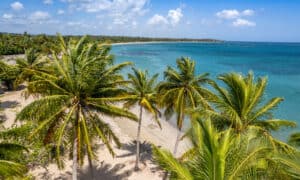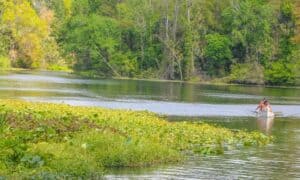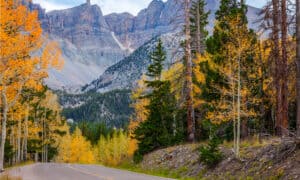It’s hard to imagine a more magical place to be than in Canada’s oldest national park, located in the Canadian Rockies. Established in 1885, Banff National Park is a remarkable piece of Canada’s history and culture. This majestic park spanning 2564 square miles, provides unparalleled beauty and exploration opportunities for visitors from all over the world. Canada’s oldest national park is a must-see destination for everyone who enjoys the great outdoors.
Why Visit Banff National Park?
Throughout its history, Banff National Park has been a source of inspiration for artists, writers, photographers, and nature lovers alike. Today, more than three million people visit Banff National Park every year, making it Canada’s most popular national park. Therefore, there is something for everyone in this remarkable piece of Canada’s history.
At Banff National Park, there are many reasons to visit and stay:
- The Views: Breathtaking mountain peaks, pristine lakes, lush forests, and meandering rivers provide a truly unique experience in Canada.
- The Wildlife: You may be lucky enough to spot Canada’s iconic wildlife, such as elk, moose, bighorn sheep, and even bears.
- The Culture: Canada’s oldest national park also offers a range of cultural attractions, including the Cave and Basin National Historic Site.
- The Activities: From hiking and camping to skiing and sightseeing, the park offers many activities for enjoying Canada’s natural beauty.
- The Education: Canada’s oldest national park also provides educational programs and activities to ensure visitors gain a better understanding of Canada’s unique environment.
- The Memories: From the magnificent views to your new sense of adventure, memories made in Banff National Park will last a lifetime.
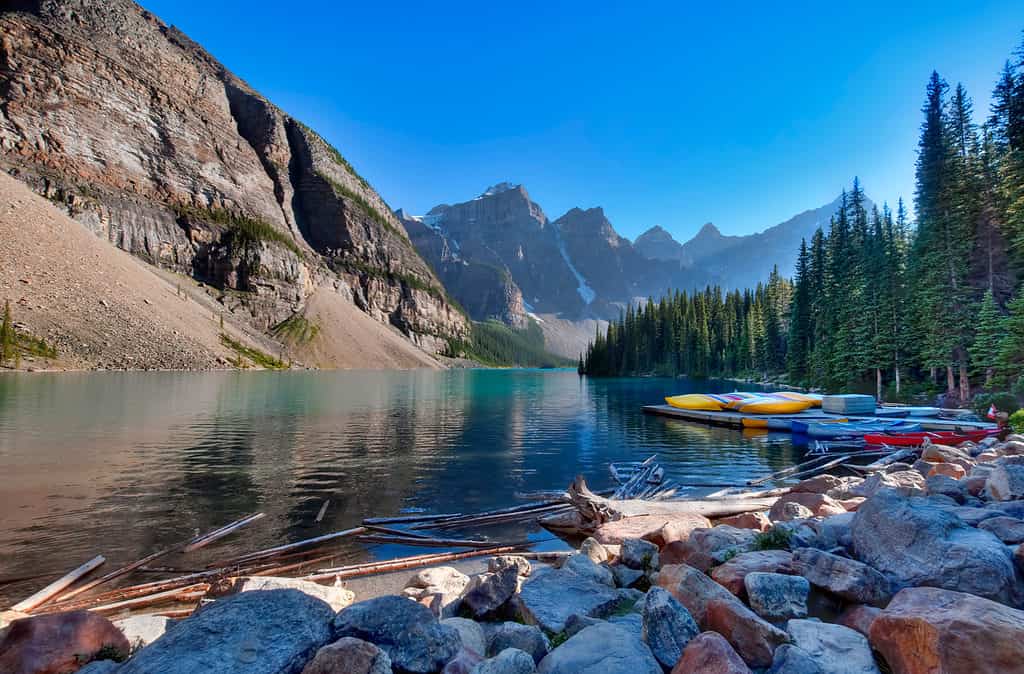
Banff National Park has been a source of inspiration for artists, writers, photographers, and nature lovers alike because of its stunning beauty.
©John Couture/Shutterstock.com
The History of Canada’s Oldest National Park
Banff National Park was established in 1885 by the Canadian government. It was originally named Rocky Mountains Park of Canada. However, the name changed to Banff National Park in 1887 after the nearby town of Banff.
The park began as means of promoting Canadian tourism and establishing the Canadian Pacific Railway’s route across the country. Later, park expansion included a reserve to protect the hot springs discovered by railroad workers in 1883.
The Must-See Beauty of Banff National Park
Banff National Park provides visitors with a stunning display of Canada’s natural beauty, from the snow-capped Rocky Mountains to the crystal-clear lakes and rivers. In addition, the park is also home to beautiful vegetation like wildflowers, coniferous forests, and alpine meadows.
The Mountains
Here are just a handful of the mountains to see and explore in Banff National Park:
- Mount Rundle – Located near Banff and Canmore, Alberta, Mount Rundle is 9675 feet high.
- Cascade Mountain – Located in the Bow River Valley and west of Calgary, Cascade Mountain is 9836 feet high.
- Mount Temple – Also located in Bow River Valley, Mount Temple is 11627 feet high.
- Tunnel Mountain – Another peak in Bow River Valley, Tunnel Mountain is 5551 feet high.
- Sulphur Mountain – Towering above Banff, Sulphur Mountain is 7486 feet high.
These mountains are known for their stunning panoramic views. Also, they provide visitors with gorgeous backdrops for unforgettable park experiences.
The Rivers and Lakes
The picturesque bodies of water at Banff National Park offer activities like canoeing and stand-up paddleboarding. In addition, fishing in designated areas at Banff National Park might bring a catch of trout or whitefish.
Canada’s Oldest National Park includes the following lakes and rivers:
- Bourgeau Lake
- Bow Lake
- Bow River
- Hector Lake
- Johnston Creek
- Kananaskis River
- Lake Louise
- Lake Minnewanka
- Peyto Lake
- Moraine Lake
- Vermilion Lakes

Lake Louise has beautiful, turquoise blue water fed by glacier melt.
©Darren J. Bradley/Shutterstock.com
The Trees and Vegetation
There’s no shortage of trees and plants to discover at Canada’s oldest national park. We’d be typing for days if we tried to name even a third of them. Trust that most plant enthusiasts have plenty of vegetation to discover here.
Tree varieties at Banff National Park include:
- Douglas Fir
- Lodgepole Pine
- Englemann Spruce
- Whitebark pine.
Some of the park’s most notable plants include:
- Fireweed
- Canada Thistle
- Arrowleaf Balsamroot
Hiking in Banff National Park
For those looking for a more leisurely way to explore Canada’s oldest national park, there are plenty of hiking trails to choose from. These trails wind their way through the forest, up mountainsides, and along rivers, offering visitors stunning views of Canada’s wild beauty. Trails in Banff National Park range from easy to difficult and are grouped by their general location.
Here’s a sample of some of the trails as designated by Parks Canada:
Banff Area Trails:
- Fenland Trail – 1.3 miles (easy)
- Tunnel Mountain Summit – 1.5 miles one way (moderate)
- Cory Pass Loop – 8 miles one way (difficult)
Castle Junction Trails:
- Castle Lookout – 2.3 miles one way (moderate)
- Taylor Lake – 4 miles one way (difficult)
Lake Louise Trails:
- Bow River Loop – 4.4-mile loop (easy)
- Lake Agnes – 2.1 miles (moderate)
- Fairview Mountain – 3.2 miles to the summit (difficult)
Icefields Parkway Trails:
- Peyto Lake Viewpoint – 0.37 miles (easy)
- Bow Glacier Falls – 2.9 miles (moderate)
- Dolomite Pass – 5.6 miles (difficult)
Always follow trail safety guidelines and check daily for avalanche warnings before venturing out.
Banff National Park Wildlife
Banff National Park is also famous for its abundant wildlife, which includes elk, deer, wolves, coyotes, and bears, just to name a few. Whether bird watching, fishing, or observing large animals from afar, Banff National Park is an animal lover’s haven. Additionally, visitors can observe animals in their natural habitat while learning more about Canada’s history and culture.
The best areas to see wildlife in the park include the valleys, meadows, and forests. Or just take a long drive on Bow Valley Parkway (Highway 1A) to spot the occasional bear or deer along the road. Be cautious of animals crossing the road, and always follow the park’s wildlife safety guidelines.
Tourists can also join one of the many guided wildlife tours available in and around Banff National Park.
Common wildlife that visitors might see in Canada’s Oldest National Park:
- Bald Eagle
- Black Bear
- Bighorn Sheep
- Brook Trout
- Brown Trout
- Canada Goose
- Caribou
- Cougar
- Coyote
- Deer
- Dusky Grouse
- Elk
- Grizzly Bear
- Hoary Marmot
- House Sparrow
- Lake Trout
- Lake Whitefish
- Mallard
- Mountain Chickadee
- Mountain Lion
- Mountain Whitefish
- Osprey
- Pika
- Porcupine
- Rainbow Trout
- Robin
- Starling
- Wolf
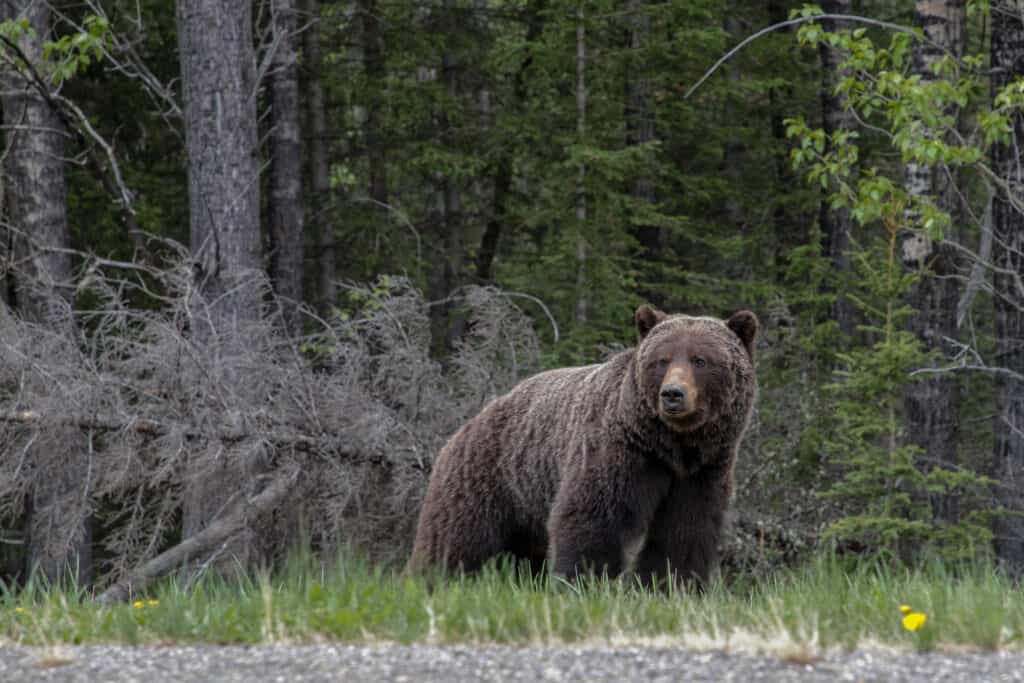
Banff National Park is known for its abundant wildlife including grizzly bears.
©iStock.com/Matthew James Ferguson
Unique Attractions at Canada’s Oldest National Park
Banff National Park has many cultural attractions, ski slopes, and fun activities, making Canada’s oldest national park a must-see destination for travelers. Thus, from historical sites to federal heritage buildings, the park has many offerings for cultural education.
Some of the cultural attractions in Banff National Park include:
- Banff Park Museum National Historic Site
- Cave and Basin National Historic Site
- Sulphur Mountain Cosmic Ray Station National Historic Site
- Canadian Pacific Railway Stations (Banff and Lake Louise)
- Cascades of Time Garden Buildings
In addition to cultural sites, the park is home to Canada’s largest ski resort, Lake Louise Ski Resort. Other attractions inside the park include the famous Banff Gondola, which takes visitors to the summit of Sulphur Mountain for stunning views of the Canadian Rockies. In addition to the incredible mountaintop views, you can shop, dine, and enjoy live entertainment inside the Banff Gondola’s Discovery Centre.
In addition to all these attractions, Banff National Park offers a variety of activities, such as horseback riding, mountain biking, canoeing, and rafting. Visitors can also enjoy plenty of accommodations, dining, and entertainment in Banff and surrounding areas.
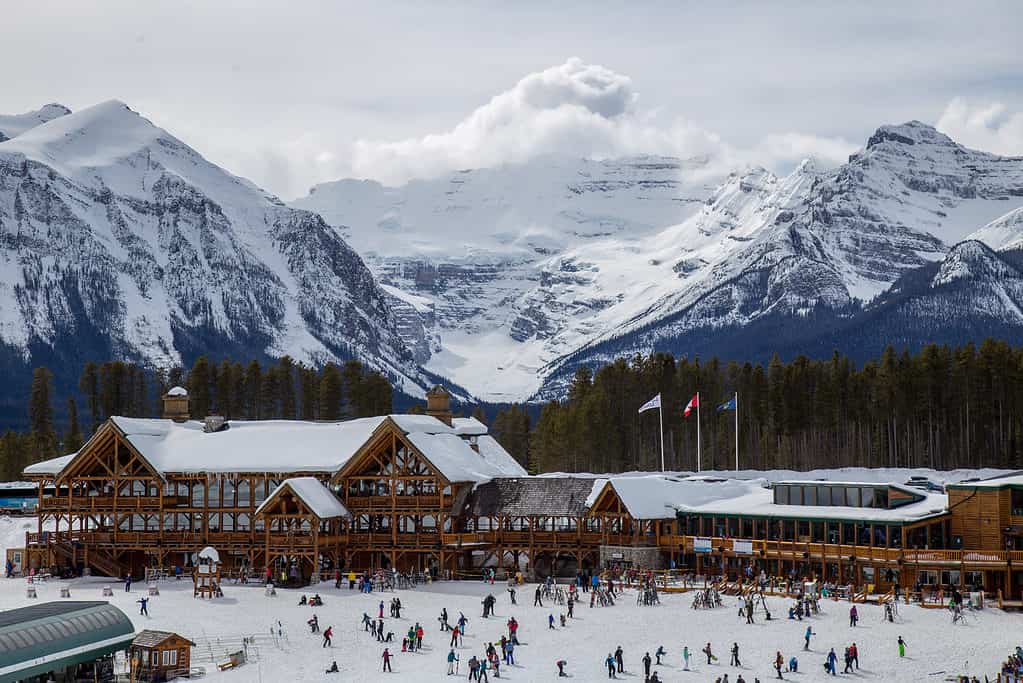
Banff National Park is home to the Lake Louise Ski Resort which is Canada’s largest ski resort.
©CSNafzger/Shutterstock.com
Banff National Park is a Must-See Destination!
Canada’s oldest national park and surrounding area offer a variety of activities, accommodations, dining, and entertainment options for visitors. With so much to do and see, Banff National Park should be near the top of your list of Canadian destinations!
Up Next
The photo featured at the top of this post is © iStock.com/Leamus
Sources
- Discover Banff Tours, Available here: https://www.banfftours.com/where-to-spot-wildlife-in-banff
- Banff & Lake Louise, Available here: https://www.banfflakelouise.com/blog/9-bucket-list-hikes-banff-national-park
- Banff & Lake Louise, Available here: https://www.banfflakelouise.com/history-heritage
Thank you for reading! Have some feedback for us? Contact the AZ Animals editorial team.



